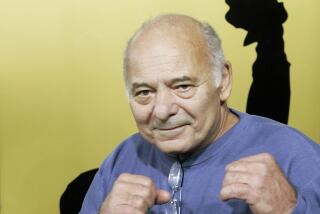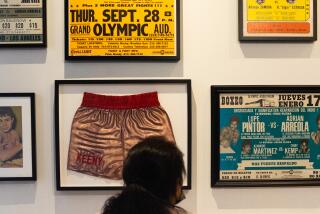‘Rocky’ a Philly Winner for 25 Years
PHILADELPHIA — A lot has changed in this gritty city since Rocky Balboa stormed up the steps of the Philadelphia Museum of Art on film, 25 years ago this week.
The boxer’s old Italian neighborhood in Kensington speaks mostly Spanish now. The grocers in the Italian Market are more likely to be Vietnamese or Cambodian. But one thing hasn’t changed: This is still a city proud of its underdogs.
“It was the first film to show how Philadelphians feel about themselves,” said Sharon Pinkenson, a longtime city resident and director of the Philadelphia Film Office.
“At the time of Rocky’s making, Philadelphia was a city that had a reputation for being dirty, dangerous and bankrupt. It was not a place that people relished the idea of being in or moving to.”
“Rocky” showed the dirt, Pinkenson said. But in showing the city at its economic worst, it also portrayed its people as loving, hard-working winners, capable of overcoming the worst odds.
It was an image the city has embraced for a quarter of a century. A statue of Rocky that briefly graced the top of the museum steps now stands outside the sports complex where the Eagles and 76ers play. An annual “Rocky Run” retraces Rocky’s sprint up the steps.
“I don’t think anybody here was embarrassed by the blue-collar side of ‘Rocky,’ ” Pinkenson said. “You related to this character. He was a winner, and by extension, we were all winners.”
The story of “Rocky” the film is almost as good as the rags-to-riches boxing tale of its mythical hero.
The movie was shot for less than $1 million in 1975. Principal photography in Philadelphia and Los Angeles lasted just 28 days. Sylvester Stallone was an unknown actor who had penned the “Rocky” script in a desperate bid to land himself work.
Producers expected the film to be a slightly better-than-average B picture. Instead it opened on Nov. 21, 1976, to rave reviews, won an Academy Award for best picture, made $117 million and launched four sequels.
It became an anthem for a city that refused to throw in the towel.
More to Read
The biggest entertainment stories
Get our big stories about Hollywood, film, television, music, arts, culture and more right in your inbox as soon as they publish.
You may occasionally receive promotional content from the Los Angeles Times.










